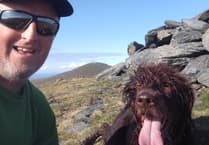Those of you who follow our social media pages will know how much people like to share photographs of their beloved pets with us, and we enjoy seeing them.
We were recently excited and amazed by photographs sent to us of the common (or not so common) lizard.
The photographs were taken by Susan Chambers, who goes to extraordinary lengths to capture images of these shy little creatures, who are lightening-quick and always stay close to undergrowth so that they can hide at the merest sign of danger.
The common lizard is the UK’s most widespread reptile, but its numbers are declining; and it’s the only reptile native to the Isle of Man.
It can be found in a variety of habitats from woodland to moorland, and you are most likely to see one between March and October – basking on a rock or wooden post, soaking up the sun.
The lizards are in the middle of their mating season now (April/May) and their young will arrive in July, with the number varying from three to 11.
The common lizard is unusual amongst reptiles because it incubates its eggs inside its body, rather than laying them, and gives birth to live young.
The lizard feeds on small invertebrates such as flies, spiders and even snails, and it hunts by day using sight and scent.
In turn they are a food source for many birds of prey, but they can often evade capture by shedding their tails which they leave behind as a decoy.
The photograph we have chosen for this article, of the many wonderful ones taken by Susan, shows a lizard shedding its skin.
A reptile’s skin doesn’t grow and so they have to shed a layer of skin, known as sloughing or molting, allowing a new, larger layer to come through.
This process also enables the lizard to get rid of any parasites it may have picked up.
If you are lucky enough to spot one you’ll see a creature about 10 to 15cm in length, with a tail that makes up over half its length, and a small, pointed head.
It is usually brown in colour with a pattern of stripes or spots down its back and sides.
Males have bright yellow or orange speckled bellies, and females have paler and plainer ones, and they can expect to live for up to seven years.
They are protected by the Wildlife Act 1990 (and the revised order in 2004) and they cannot be captured or removed except under licence.
The places where they chose to shelter are also protected and they cannot be deliberately damaged, destroyed or obstructed.
And it is also an offence to sell, trade, injure or kill the common lizard.
These amazing little creatures need sunshine to heat up their bodies in order to remain active, and so they hibernate between October and March underneath rocks and fallen logs.
As Susan will testify, a good tip for lizard spotting is to walk slowly along a path, scanning either side for possible basking sites.
The rustling movement of a lizard darting for cover is often the first sign you’ll get of their presence, but it’s worth waiting quietly when this happens because lizards tend to stick to the same sunbathing spots and will return to them.
If you do see a common lizard then please let Manx Wildlife Trust know (email: [email protected]), ideally with a grid reference and a photograph, so that they can map the distribution of lizards around the island and try to measure their population.


.jpeg?width=209&height=140&crop=209:145,smart&quality=75)


Comments
This article has no comments yet. Be the first to leave a comment.